Synthesis of CF3-Containing Spiro-[Indene-Proline] Derivatives via Rh(III)-Catalyzed C-H Activation/Annulation
Abstract
:1. Introduction
2. Results and Discussion
3. Materials and Methods
3.1. General Information
3.2. General Procedure for the Synthesis of 5-Aryl Dehydroprolines 2a-d
3.3. General Procedure for the C-H Activation/Annulation of 5-Aryl Dehydroprolines with Tolane Derivatives. Synthesis of the Compounds 4a-m




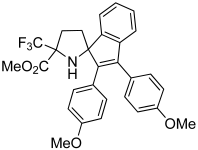



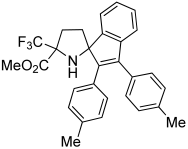
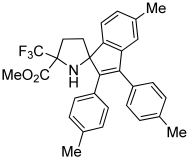
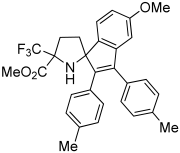
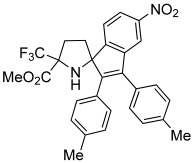
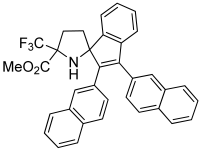
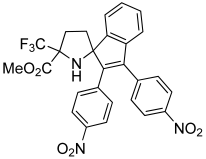


4. Conclusions
Supplementary Materials
Author Contributions
Funding
Institutional Review Board Statement
Informed Consent Statement
Data Availability Statement
Acknowledgments
Conflicts of Interest
References
- Ding, A.; Meazza, M.; Guo, H.; Yang, J.W.; Rios, R. New development in the enantioselective synthesis of spiro compounds. Chem. Soc. Rev. 2018, 47, 5946–5996. [Google Scholar] [CrossRef]
- Phukon, J.; Borah, A.J.; Gogoi, S. Transition-metal-catalyzed synthesis of spiro compounds through activation and cleavage of C-H bonds. Asian J. Org. Chem. 2022, 11, e202200581. [Google Scholar] [CrossRef]
- Zhou, M.-B.; Pi, R.; Hu, M.; Yang, Y.; Song, R.-J.; Xia, Y.; Li, J.-H. Rhodium(III)-catalyzed [3+2] annulation of 5-aryl-2,3-dihydro-1Hpyrroles with internal alkynes through C(sp2)-H/alkene functionalization. Angew. Chem. Int. Ed. 2014, 53, 11338–11341. [Google Scholar] [CrossRef]
- Mercado-Marin, E.V.; Garcia-Reynaga, P.; Romminger, S.; Pimenta, E.F.; Romney, D.K.; Lodewyk, M.W.; Williams, D.E.; Andersen, R.J.; Miller, S.J.; Tantillo, D.J.; et al. Total synthesis and isolation of citrinalin and cyclopiamine congeners. Nature 2014, 509, 318–324. [Google Scholar] [CrossRef]
- Dillard, L.W.; Yuan, J.; Leftheris, K.; Venkatraman, S.; Wu, G.; Jia, L.; Xu, Z.; Cacatian, S.; Morales-Ramos, A.; Singh, S.; et al. Inhibitors of Beta-Secretase. WIPO Patent WO2011106414A1, 24 February 2011. [Google Scholar]
- Jimonet, P.; Boireau, A.; Chevé, M.; Damour, D.; Genevois-Borella, A.; Imperato, A.; Pratt, J.; Randle, J.C.R.; Ribeill, Y.; Stutzmann, J.-M.; et al. Spiro-imidazo [1,2-a]indeno [1,2-e]pyrazine-4-one derivatives are mixed AMPA and NMDA glycine-site antagonists active in vivo. Bioorg. Med. Chem. Lett. 1999, 9, 2921–2926. [Google Scholar] [CrossRef] [PubMed]
- Firestone, A.J.; Chen, J.K. Controlling destiny through chemistry: Small-molecule regulators of cell fate. ACS Chem. Biol. 2010, 5, 15–34. [Google Scholar] [CrossRef] [PubMed]
- Wrobel, J.; Dietrich, A.; Woolson, S.A.; Millen, J.; McCaleb, M.; Harrison, M.C.; Hohman, T.C.; Sredy, J.; Sullivan, D. Novel spirosuccinimides with incorporated isoindolone and benzisothiazole 1,1-dioxide moieties as aldose reductase inhibitors and antihyperglycemic agents. J. Med. Chem. 1992, 35, 4613–4627. [Google Scholar] [CrossRef] [PubMed]
- Waespe, H.R.; van Lommen, G.R.E.; Sipido, V.K. Isonicotinic Acid Derivatives and Related Spiro Compounds with Herbicidal Action. WIPO Patent WO9209577A1, 11 June 1992. [Google Scholar]
- Saraswat, P.; Jeyabalan, G.; Hassan, M.Z.; Rahman, M.U.; Nyola, N.K. Review of synthesis and various biological activities of spiro heterocyclic compounds comprising oxindole and pyrrolidine moieties. Synth. Commun. 2016, 46, 1643–1664. [Google Scholar] [CrossRef]
- Newton, C.G.; Wang, S.-G.; Oliveira, C.C.; Cramer, N. Catalytic enantioselective transformations involving C-H bond cleavage by transition-metal complexes. Chem. Rev. 2017, 117, 8908–8976. [Google Scholar] [CrossRef] [PubMed]
- Park, Y.; Kim, Y.; Chang, S. Transition metal-catalyzed C-H amination: Scope, mechanism, and applications. Chem. Rev. 2017, 117, 9247–9301. [Google Scholar] [CrossRef]
- Chen, J.-R.; Hu, X.-Q.; Lu, L.-Q.; Xiao, W.-J. Formal [4+1] annulation reactions in the synthesis of carbocyclic and heterocyclic systems. Chem. Rev. 2015, 115, 5301–5365. [Google Scholar] [CrossRef] [PubMed]
- Ackermann, L. Carboxylate-assisted ruthenium-catalyzed alkyne annulations by C-H/Het-H bond functionalizations. Acc. Chem. Res. 2014, 47, 281–295. [Google Scholar] [CrossRef] [PubMed]
- Upadhyay, N.S.; Thorat, V.H.; Sato, R.; Annamalai, P.; Chuang, S.-C.; Cheng, C.-H. Synthesis of isoquinolones via Rh-catalyzed C-H activation of substituted benzamides using air as the sole oxidant in water. Green Chem. 2017, 19, 3219–3224. [Google Scholar] [CrossRef]
- Reddy Chidipudi, S.; Burns, D.J.; Khan, I.; Lam, H.W. Enantioselective synthesis of spiroindenes by enol-directed rhodium(III)-catalyzed C-H functionalization and spiroannulation. Angew. Chem. Int. Ed. 2015, 54, 13975–13979. [Google Scholar] [CrossRef]
- Zhang, X.; Si, W.; Bao, M.; Asao, N.; Yamamoto, Y.; Jin, T. Rh(III)-Catalyzed regioselective functionalization of C-H bonds of naphthylcarbamates for oxidative annulation with alkynes. Org. Lett. 2014, 16, 4830–4833. [Google Scholar] [CrossRef] [PubMed]
- Chuang, S.-C.; Gandeepan, P.; Cheng, C.-H. Synthesis of isoquinolines via Rh(III)-catalyzed C-H activation using hydrazone as a new oxidizing directing group. Org. Lett. 2013, 15, 5750–5753. [Google Scholar] [CrossRef] [PubMed]
- Pham, M.V.; Ye, B.; Cramer, N. Access to sultams by rhodium(III)-catalyzed directed C-H activation. Angew. Chem. Int. Ed. 2012, 51, 10610–10614. [Google Scholar] [CrossRef]
- Hyster, T.K.; Rovis, T. Rhodium-catalyzed oxidative cycloaddition of benzamides and alkynes via C-H/N-H activation. J. Am. Chem. Soc. 2010, 132, 10565–10569. [Google Scholar] [CrossRef]
- Song, G.; Chen, D.; Pan, C.-L.; Crabtree, R.H.; Li, X. Rh-Catalyzed oxidative coupling between primary and secondary benzamides and alkynes: Synthesis of polycyclic amides. J. Org. Chem. 2010, 75, 7487–7490. [Google Scholar] [CrossRef]
- Guimond, N.; Gorelsky, S.I.; Fagnou, K. Rhodium(III)-catalyzed heterocycle synthesis using an internal oxidant: Improved reactivity and mechanistic studies. J. Am. Chem. Soc. 2011, 133, 6449–6457. [Google Scholar] [CrossRef]
- Liu, Z.; Zhang, W.; Guo, S.; Zhu, J. Spiro[indene-1,4′-oxa-zolidinones] synthesis via Rh(III)-catalyzed coupling of 4-phenyl-1,3-oxazol-2(3H)-ones with alkynes: A redox-neutral approach. J. Org. Chem. 2019, 84, 11945–11957. [Google Scholar] [CrossRef]
- Ojima, I. Fluorine in Medicinal Chemistry and Chemical Biology; Wiley-Blackwell: Chichester, UK, 2009. [Google Scholar]
- Jaeckel, C.; Koksch, B. Fluorine in peptide design and protein engineering. Eur. J. Org. Chem. 2005, 37, 4483–4503. [Google Scholar] [CrossRef]
- Smits, R.; Cadicamo, C.D.; Burger, K.; Koksch, B. Synthetic strategies to α-trifluoromethyl and α-difluoromethyl substituted α-amino acids. Chem. Soc. Rev. 2008, 37, 1727–1739. [Google Scholar] [CrossRef] [PubMed]
- Salwiczek, M.; Nyakatura, E.K.; Gerling, U.I.; Ye, S.; Koksch, B. Fluorinated amino acids: Compatibility with native protein structures and effects on protein-protein interactions. Chem. Soc. Rev. 2012, 41, 2135–2171. [Google Scholar] [CrossRef]
- Moschner, J.; Stulberg, V.; Fernandes, R.; Huhmann, S.; Leppkes, J.; Koksch, B. Approaches to obtaining fluorinated α-amino acid. Chem. Rev. 2019, 119, 10718–10801. [Google Scholar] [CrossRef] [PubMed]
- Vorobyeva, D.V.; Petropavlovskikh, D.A.; Godovikov, I.A.; Nefedov, S.E.; Osipov, S.N. Rh(III)-Catalyzed C-H activation/annulation of aryl hydroxamates with CF3-containing α-propargyl α-amino acid derivatives. Eur. J. Org. Chem. 2021, 2021, 1883–1890. [Google Scholar] [CrossRef]
- Vorobyeva, D.V.; Petropavlovskikh, D.A.; Godovikov, I.A.; Dolgushin, F.M.; Osipov, S.N. Synthesis of functionalized isoquinolone derivatives via Rh(III)-catalyzed [4+2]-annulation of benzamides with internal acetylene-containing α-CF3-α-amino carboxylates. Molecules 2022, 27, 8488. [Google Scholar] [CrossRef] [PubMed]
- Vorobyeva, D.V.; Bubnova, A.S.; Godovikov, I.A.; Danshina, A.A.; Osipov, S.N. Rh(III)-Catalyzed [4+2]-annulation of indoles: Access to functionalized pyrimidoindolones containing α-amino acid framework. Asian J. Org. Chem. 2023, 12, e202200485. [Google Scholar] [CrossRef]
- Petropavlovskikh, D.A.; Vorobyeva, D.V.; Godovikov, I.A.; Nefedov, S.E.; Filippov, O.A.; Osipov, S.N. Lossen rearrangement by Rh(III)-catalyzed C-H activation/annulation of aryl hydroxamates with alkynes: Access to quinolone-containing amino acid derivatives. Org. Biomol. Chem. 2021, 19, 9421–9426. [Google Scholar] [CrossRef]
- Philippova, A.N.; Vorobyeva, D.V.; Gribanov, P.S.; Godovikov, I.A.; Osipov, S.N. Synthesis of functionalized azepines via Cu(I)-catalyzed tandem amination/cyclization reaction of fluorinated allenynes. Molecules 2022, 27, 5195. [Google Scholar] [CrossRef]
- Vorobyeva, D.V.; Bubnova, A.S.; Buyanovskaya, A.G.; Osipov, S.N. Synthesis of CF3-substituted isoindolones via rhodium(III)-catalyzed carbenoid C-H functionalization of aryl hydroxamates. Mendeleev Commun. 2023, 33, 34–36. [Google Scholar] [CrossRef]
- Zotova, M.A.; Vasilyeva, T.P.; Osipov, S.N. Intramolecular cyclization of acetylene-containing α-amino carboxylates and α-amino phosphonates: Synthesis of α-CF3-substituted dehydroprolines and their P-analogs. Russ. Chem. Bull. 2013, 62, 792–795. [Google Scholar] [CrossRef]
- Shchetnikov, G.T.; Zotova, M.A.; Bruneau, C.; Dixneuf, P.H.; Osipov, S.N. Synthesis of α-alkynyl-β,β,β-trifluoroalanine derivatives by Sonogashira cross-coupling reaction. Eur. J. Org. Chem. 2010, 112, 1587–1592. [Google Scholar] [CrossRef]
- Dong, L.; Qu, C.-H.; Huang, J.-R.; Zhang, W.; Zhang, Q.-R.; Deng, J.-G. Rhodium-catalyzed spirocyclic sultam synthesis by [3+2] annulation with cyclic N-sulfonyl ketimines and alkynes. Chem. Eur. J. 2013, 19, 16537–16540. [Google Scholar] [CrossRef]
- Pham, M.V.; Cramer, N. Enantioselective access to spirocyclic sultams by chiral Cpx-rhodium(III)-catalyzed annulations. Chem. Eur. J. 2016, 22, 2270–2273. [Google Scholar] [CrossRef]
- Shabalin, D.A.; Kazak, M.K.; Ushakov, I.A.; Vashchenko, A.V.; Schmidt, E.Y. Synthesis of pyrrolo[2,1-a]isoquinolinium salts from 1-pyrrolines and alkynes via rhodium-catalyzed C-H functionalization/N-annulation tandem reaction. J. Org. Chem. 2022, 87, 6860–6869. [Google Scholar] [CrossRef]
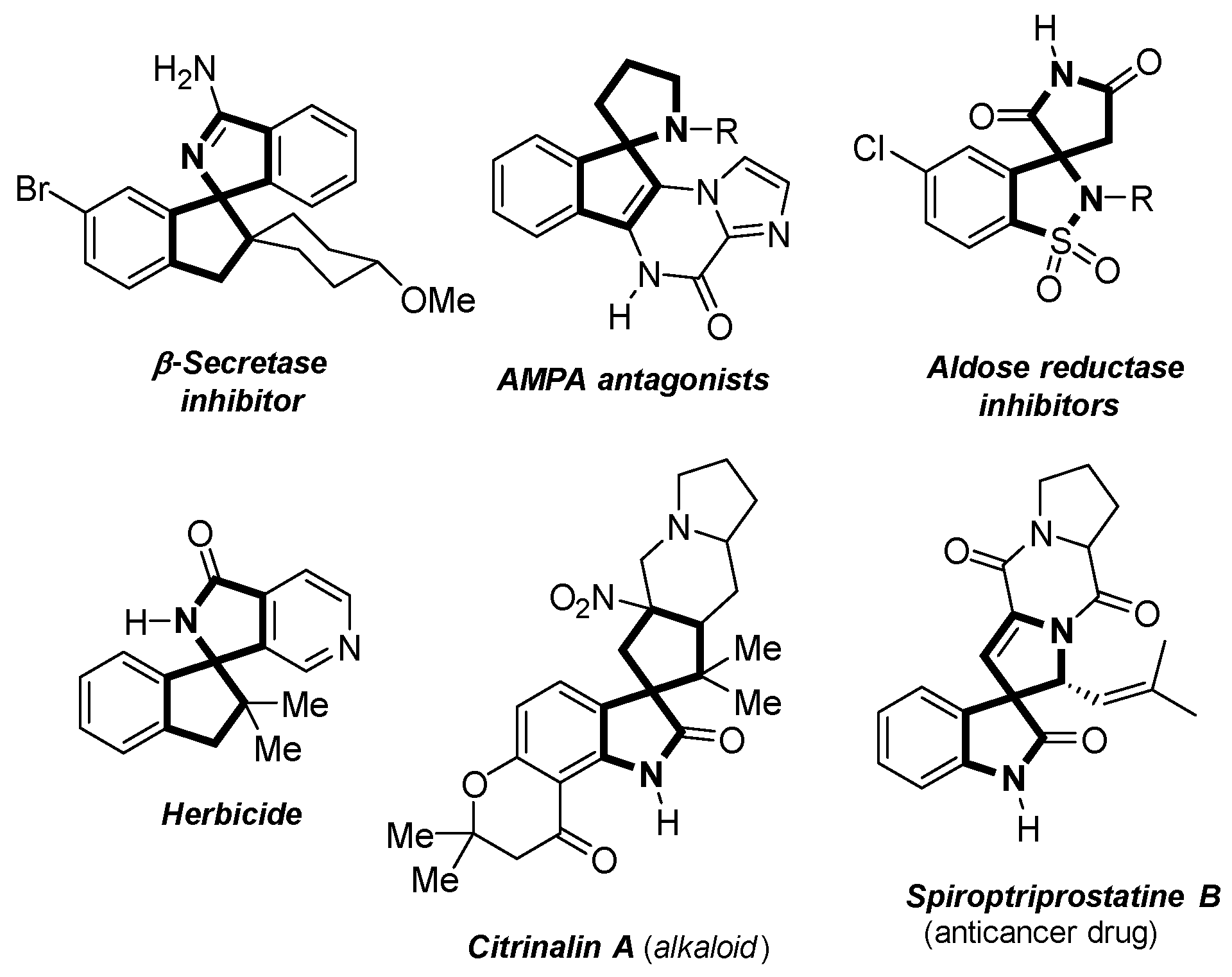




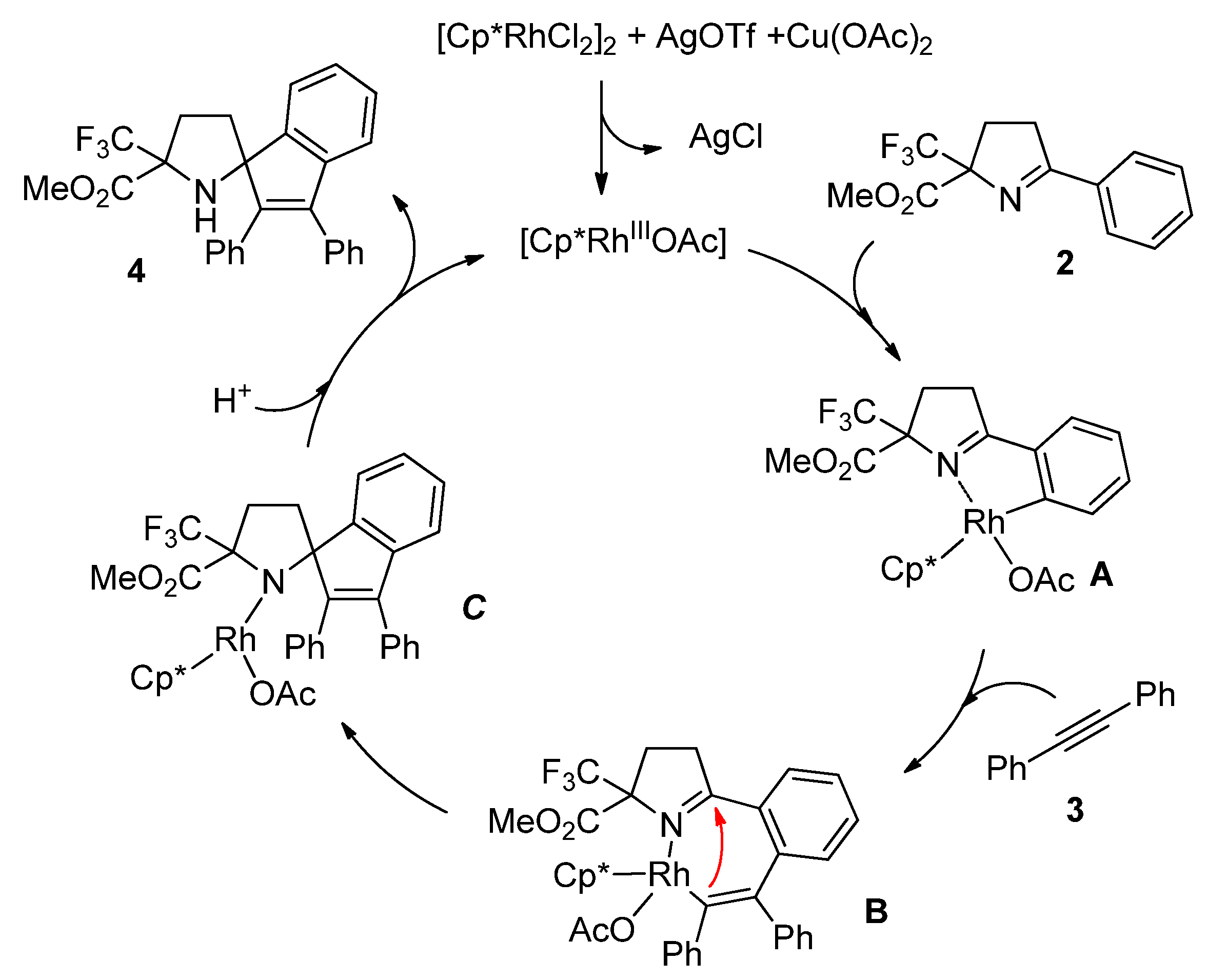

| Entry | Catalyst (mol%) | Ag Additive (Equiv.) | Other Additive (Equiv.) | Yield 2 (%) |
|---|---|---|---|---|
| 1 | [Cp*RhCl2]2 (5) | AgBF4 (0.3) | - | 41(28 3) |
| 2 | [Cp*RhCl2]2 (5) | AgBF4 (1) | - | 39 |
| 3 | [Cp*RhCl2]2 (5) | AgOTf (1) | - | 43 |
| 4 | [Cp*RhCl2]2 (5) | AgOTf (1) | Cu(OAc)2∙H2O (1) | 71 |
| 5 | [Cp*RhCl2]2 (2) | AgOTf (1) | Cu(OAc)2∙H2O (1) | 42 |
| 6 | [Cp*RhCl2]2 (5) | AgOTf (1) | Cu(OAc)2∙H2O (2) | 63 |
| 7 | [Cp*RhCl2]2 (5) | AgOAc (0.3) | Cu(OAc)2∙H2O (1) | NR |
| 8 | [Cp*RhCl2]2 (5) | AgOTf (0.3) | Cu(OAc)2∙H2O (1) | 80 |
| 9 | [Cp*RhCl2]2 (5) | AgBF4 (0.3) | Cu(OAc)2∙H2O (1) | 77 |
| 10 | [Cp*RhCl2]2 (5) | AgSbF6 (0.3) | Cu(OAc)2∙H2O (1) | 79 |
| 11 | [Cp*RhCl2]2 (5) | AgOTf (0.3) | Cu(OAc)2∙H2O (0.5) | 88(75 3) |
| 12 | [Cp*RhCl2]2 (5) | AgOTf (0.3) | CsOAc (2) | 19 |
| 13 | [Cp*RhCl2]2 (5) | AgOTf (0.3) | Zn(OAc)2∙H2O (2) | 56 |
| 14 | [Cp*RhCl2]2 (5) | - | Cu(OAc)2∙H2O (1) | NR |
| 15 | [Cp*IrCl2]2 (7) | AgOTf (1) | Cu(OAc)2∙H2O (1) | NR |
| 16 | [Cp*CoI2]2 (10) | AgOTf (1) | Cu(OAc)2∙H2O (1) | NR |
Disclaimer/Publisher’s Note: The statements, opinions and data contained in all publications are solely those of the individual author(s) and contributor(s) and not of MDPI and/or the editor(s). MDPI and/or the editor(s) disclaim responsibility for any injury to people or property resulting from any ideas, methods, instructions or products referred to in the content. |
© 2023 by the authors. Licensee MDPI, Basel, Switzerland. This article is an open access article distributed under the terms and conditions of the Creative Commons Attribution (CC BY) license (https://creativecommons.org/licenses/by/4.0/).
Share and Cite
Bubnova, A.S.; Vorobyeva, D.V.; Godovikov, I.A.; Smol’yakov, A.F.; Osipov, S.N. Synthesis of CF3-Containing Spiro-[Indene-Proline] Derivatives via Rh(III)-Catalyzed C-H Activation/Annulation. Molecules 2023, 28, 7809. https://doi.org/10.3390/molecules28237809
Bubnova AS, Vorobyeva DV, Godovikov IA, Smol’yakov AF, Osipov SN. Synthesis of CF3-Containing Spiro-[Indene-Proline] Derivatives via Rh(III)-Catalyzed C-H Activation/Annulation. Molecules. 2023; 28(23):7809. https://doi.org/10.3390/molecules28237809
Chicago/Turabian StyleBubnova, Alexandra S., Daria V. Vorobyeva, Ivan A. Godovikov, Alexander F. Smol’yakov, and Sergey N. Osipov. 2023. "Synthesis of CF3-Containing Spiro-[Indene-Proline] Derivatives via Rh(III)-Catalyzed C-H Activation/Annulation" Molecules 28, no. 23: 7809. https://doi.org/10.3390/molecules28237809
APA StyleBubnova, A. S., Vorobyeva, D. V., Godovikov, I. A., Smol’yakov, A. F., & Osipov, S. N. (2023). Synthesis of CF3-Containing Spiro-[Indene-Proline] Derivatives via Rh(III)-Catalyzed C-H Activation/Annulation. Molecules, 28(23), 7809. https://doi.org/10.3390/molecules28237809






